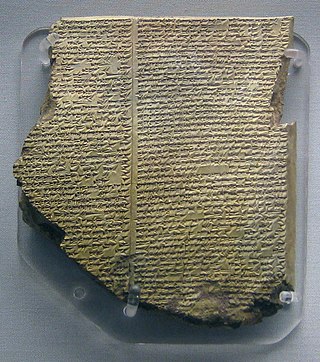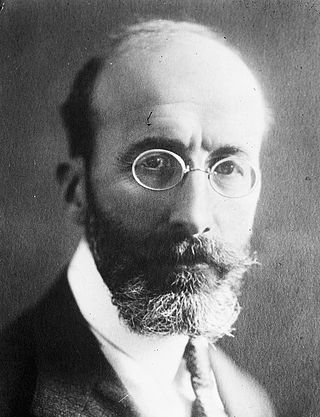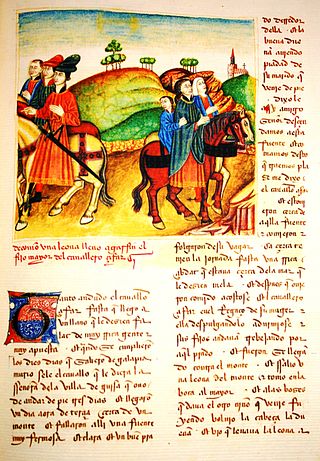Related Research Articles

An epic poem, or simply an epic, is a lengthy narrative poem typically about the extraordinary deeds of extraordinary characters who, in dealings with gods or other superhuman forces, gave shape to the mortal universe for their descendants.

Rodrigo Díaz de Vivar was a Castilian knight and warlord in medieval Spain. Fighting with both Christian and Muslim armies during his lifetime, he earned the Arabic honorific as-Sayyid, which would evolve into El Cid, and the Spanish honorific El Campeador. He was born in Vivar, a village near the city of Burgos. As the head of his loyal knights, he came to dominate the Levante of the Iberian Peninsula at the end of the 11th century. He reclaimed the Taifa of Valencia from Muslim control for a brief period during the Reconquista, ruling the principality as its Prince from 17 June 1094 until his death in 1099. His wife, Jimena Díaz, inherited the city and maintained it until 1102 when it was reconquered by the Moors.

Federico del Sagrado Corazón de Jesús García Lorca, known as Federico García Lorca, was a Spanish poet, playwright, and theatre director. García Lorca achieved international recognition as an emblematic member of the Generation of '27, a group consisting mostly of poets who introduced the tenets of European movements into Spanish literature.

Medieval literature is a broad subject, encompassing essentially all written works available in Europe and beyond during the Middle Ages. The literature of this time was composed of religious writings as well as secular works. Just as in modern literature, it is a complex and rich field of study, from the utterly sacred to the exuberantly profane, touching all points in-between. Works of literature are often grouped by place of origin, language, and genre.
A kharja or kharjah, is the final refrain of a muwashshah, a lyric genre of Al-Andalus written in Arabic or Andalusi Romance (Mozarabic).

Andalusi Romance, also called Mozarabic or Ajami, refers to the varieties of Ibero-Romance that developed in Al-Andalus, the parts of the medieval Iberian Peninsula under Islamic control. Romance, or vernacular Late Latin, was the common tongue for the majority of the population in the wake of the Umayyad conquest in the early eighth century. Over the following centuries, it was gradually superseded by Andalusi Arabic as the main spoken language in the Muslim-controlled south. At the same time, as the northern Christian kingdoms pushed south into Al-Andalus, their respective Romance varieties gained ground at the expense of Andalusi Romance as well as Arabic. The final extinction of the former may be estimated to 1300 CE.

El Cantar de mio Cid, or El Poema de mio Cid, also known in English as The Poem of the Cid, is the oldest preserved Castilian epic poem. Based on a true story, it tells of the deeds of the Castilian hero Rodrigo Díaz de Vivar—known as El Cid—and takes place during the eleventh century, an era of conflicts in the Iberian Peninsula between the Kingdom of Castile and various Taifa principalities of Al-Andalus. It is considered a national epic of Spain.

Spanish literature generally refers to literature written in the Spanish language within the territory that presently constitutes the Kingdom of Spain. Its development coincides and frequently intersects with that of other literary traditions from regions within the same territory, particularly Catalan literature, Galician intersects as well with Latin, Jewish, and Arabic literary traditions of the Iberian peninsula. The literature of Spanish America is an important branch of Spanish literature, with its own particular characteristics dating back to the earliest years of Spain’s conquest of the Americas.

As a literary genre, the chivalric romance is a type of prose and verse narrative that was popular in the noble courts of high medieval and early modern Europe. They were fantastic stories about marvel-filled adventures, often of a chivalric knight-errant portrayed as having heroic qualities, who goes on a quest. It developed further from the epics as time went on; in particular, "the emphasis on love and courtly manners distinguishes it from the chanson de geste and other kinds of epic, in which masculine military heroism predominates."
This article concerns poetry in Spain.

Medieval French literature is, for the purpose of this article, Medieval literature written in Oïl languages during the period from the eleventh century to the end of the fifteenth century.
Latin American poetry is the poetry written by Latin American authors. Latin American poetry is often written in Spanish, but is also composed in Portuguese, Mapuche, Nahuatl, Quechua, Mazatec, Zapotec, Ladino, English, and Spanglish. The unification of Indigenous and imperial cultures produced a unique and extraordinary body of literature in this region. Later with the introduction of African slaves to the new world, African traditions greatly influenced Latin American poetry. Many great works of poetry were written in the colonial and pre-colonial time periods, but it was in the 1960s that the world began to notice the poetry of Latin America. Through the modernismo movement, and the international success of Latin American authors, poetry from this region became increasingly influential.

Ramón Menéndez Pidal was a Spanish philologist and historian. He worked extensively on the history of the Spanish language and Spanish folklore and folk poetry. One of his main topics was the history and legend of El Cid. He was nominated for the Nobel Prize in 26 separate years, thus, being the most nominated person.

The Mocedades de Rodrigo is the name given to a late, anonymous Castilian cantar de gesta, composed around 1360, that relates the origins and exploits of the youth of the legendary hero El Cid.
Spanish Renaissance literature is the literature written in Spain during the Spanish Renaissance during the 15th and 16th centuries..
Lorenzo de Sepúlveda was a Spanish writer best known as the author of romances in verse.

Medieval Spanish literature consists of the corpus of literary works written in medieval Spanish between the beginning of the 13th and the end of the 15th century. Traditionally, the first and last works of this period are taken to be respectively the Cantar de Mio Cid, an epic poem whose manuscript dates from 1207, and La Celestina (1499), a work commonly described as transitional between the medieval period and the Renaissance.
Samuel Gordon Armistead was an American ethnographer, linguist, folklorist, historian, literary critic and professor of Spanish. He is considered one of the most notable Hispanist scholars of the second half of the 20th and early 21st century.

The Romancero gitano is a poetry collection by Spanish writer Federico García Lorca. First published in 1928, it is composed of eighteen romances with subjects like the night, death, the sky, and the moon. All of the poems deal with the Romani people (gypsies) and their culture, but only as a theme used to carry the larger message that the poet was trying to convey.

The Cantar de los Siete Infantes de Lara is a legend, perhaps derived from a lost cantar de gesta, that relates a tale of family feuding and revenge, centering on the murder of the eponymous seven infantes (princes) of Lara or Salas. The legend survives in prose form in medieval chronicles, the oldest being in the extended version of the Estoria de España compiled during the reign of Sancho IV of Castile before 1289.
References
- ↑ "Romancero | Traditional, Ballads & Poetry | Britannica". www.britannica.com. Retrieved 2023-10-03.
- Romancero. (2011). In Encyclopædia Britannica. Retrieved on 22 February 2011.
- Romancero tradicional de las lenguas hispánicas. Ed. by R. Menéndez Pidal, D. Catalán, et al. Madrid: Editorial Gredos, 1957-85). 12 vols.
- Katz, Israel J. "Romancero," Diccionario de la Música Española e Hispanoamericana (Madrid: Sociedad General de Autores y Editores, 2002).